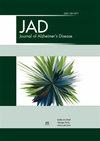Quantitative EEG Spectral and Connectivity Analysis for Cognitive Decline in Amnestic Mild Cognitive Impairment
IF 3.4
3区 医学
Q2 NEUROSCIENCES
引用次数: 0
Abstract
Background: Mild cognitive impairment (MCI) is considered to be the borderline of cognitive changes associated with aging and very early dementia. Cognitive functions in MCI can improve, remain stable or progress to clinically probable AD. Quantitative electroencephalography (qEEG) can become a useful tool for using the analytical techniques to quantify EEG patterns indicating cognitive impairment. Objective: The aim of our study was to assess spectral and connectivity analysis of the EEG resting state activity in amnestic MCI (aMCI) patients in comparison with healthy control group (CogN). Methods: 30 aMCI patients and 23 CogN group, matched by age and education, underwent equal neuropsychological assessment and EEG recording, according to the same protocol. Results: qEEG spectral analysis revealed decrease of global relative beta band power and increase of global relative theta and delta power in aMCI patients. Whereas, decreased coherence in centroparietal right area considered to be an early qEEG biomarker of functional disconnection of the brain network in aMCI patients. In conclusion, the demonstrated changes in qEEG, especially, the coherence patterns are specific biomarkers of cognitive impairment in aMCI. Conclusions: Therefore, qEEG measurements appears to be a useful tool that complements neuropsychological diagnostics, assessing the risk of progression and provides a basis for possible interventions designed to improve cognitive functions or even inhibit the progression of the disease.对失忆性轻度认知障碍患者认知能力下降的脑电图频谱和连接性定量分析
背景:轻度认知障碍(MCI)被认为是与衰老和早期痴呆相关的认知变化的边缘。MCI 患者的认知功能可以改善、保持稳定或发展为临床上可能的 AD。定量脑电图(qEEG)可以成为一种有用的工具,利用分析技术量化显示认知障碍的脑电图模式。研究目的我们的研究旨在评估失忆性 MCI(aMCI)患者与健康对照组(CogN)的脑电图静息状态活动的频谱和连接性分析。方法:30 名 aMCI 患者和 23 名 CogN 组(年龄和教育程度相匹配)按照相同的方案接受相同的神经心理评估和脑电图记录。结果:qEEG频谱分析显示,aMCI患者全局相对β波段功率下降,全局相对θ和δ功率上升。而顶叶中心右区相干性的降低被认为是 aMCI 患者大脑网络功能断开的早期 qEEG 生物标记。总之,所显示的 qEEG 变化,尤其是相干性模式,是 aMCI 患者认知障碍的特异性生物标志物。结论因此,qEEG 测量似乎是一种有用的工具,可补充神经心理诊断,评估病情恶化的风险,并为旨在改善认知功能甚至抑制病情恶化的可能干预措施提供依据。
本文章由计算机程序翻译,如有差异,请以英文原文为准。
求助全文
约1分钟内获得全文
求助全文
来源期刊

Journal of Alzheimer's Disease
医学-神经科学
CiteScore
6.40
自引率
7.50%
发文量
1327
审稿时长
2 months
期刊介绍:
The Journal of Alzheimer''s Disease (JAD) is an international multidisciplinary journal to facilitate progress in understanding the etiology, pathogenesis, epidemiology, genetics, behavior, treatment and psychology of Alzheimer''s disease. The journal publishes research reports, reviews, short communications, hypotheses, ethics reviews, book reviews, and letters-to-the-editor. The journal is dedicated to providing an open forum for original research that will expedite our fundamental understanding of Alzheimer''s disease.
 求助内容:
求助内容: 应助结果提醒方式:
应助结果提醒方式:


